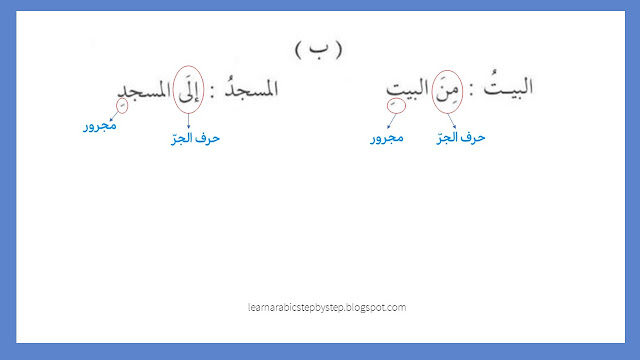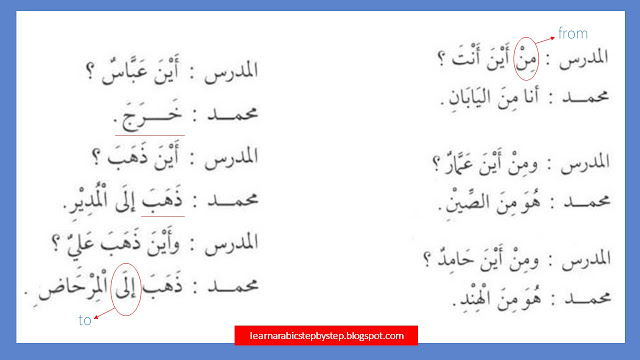Durus al-lughah Book 1 Lesson 4: huruf al-jar
Yesterday, we have studied ism nakirah and ism ma'rifah (indefinite noun and definite noun), then practicing to make a simple sentence that starts with a noun (jumlah ismiyyah).
Today, I will explain to you a preposition in Arabic (harf jarr).
The list of huruuf al-jarr which are explained in lesson 4
Please observe and study the picture below.
 |
| harf jar fii and 'alaa |
 |
| harf jar min and ilaa |
From the pictures above, we learn these points:
1. The normal ending of a noun is dammah "u".
A noun with normal ending (dammah "u") is called marfu' (مرفوع)
Marfu' is also known as nominative case.
2. We learn the examples of huruful jar (حروف الجرّ).
Huruf al-jar (prepositions) which are learned in this chapter are : fii (في), 'alaa (على), min (من), ilaa (إلى).
3. There is a noun that is located after the preposition (حرف الجرّ), this ending of this noun changes to kasrah "i".
This ending is called majrur (مجرور).
Majrur is also known as genitive case.
4. A noun which is preceded by harf jar (preposition) is said to be ism majrur.
5. Examples of jar wa majrur :
a. fil baiti (فِي البَيْتِ) = in the house.
b. 'alal maktabi (عَلَى المَكْتَبِ) = on the table.
c. minal masjidi (مِنَ البَيْتِ) = from the house.
d. ilas suuqi (إِلَى السُّوقِ) = to the market.
Question word "where" in Arabic: aina (أَيْنَ)
From the pictures above, we learn these things:
1. The question word “where” in Arabic is "aina" (أَيْنَ).
Sentence examples:
a. Where is Muhammad? ⇒ أَيْنَ مُحَمَّدُ؟
b. Where are you from? ⇒ مِنْ أَيْنَ أَنْتَ؟
2. Pronoun for 3rd person, singular, masculine is "he" (هُوَ)
Ism damir for gha-ib, mufrad, mudhakkar (غائب, مفرد, مذكّر) ⇒ huwa (هُوَ).
3. Pronoun for 3rd person, singular, feminine is "she" (هِيَ).
Ism damir for gha-ib, mufrad, mu-annath (غائب, مفرد, مؤنّث) => hiya (هِيَ).
4. Pronoun for 1st person, singular is "I" (أَنَا).
Ism damir for mutakallim, mufrad (متكلّم, مفرد) => ana (أنا).
5. Pronoun for 2nd person, singular, masculine is "you" (أَنْتَ).
Ism damir for mukhatab, mufrad, mudhakkar () => anta (أَنْتَ).
6. In this chapter, we learn two Arabic verbs, they are:
a. kharaja (خَرَجَ) => went out.
b. dhahaba (ذّهّبَ) => went.
kharaja (خَرَجَ) and dhahaba (ذَهَبَ) are called fi'l madi (الفعل المضي).
Fi'l madi (past tense) means the verb that the action has been completed.
The rule of feminine proper name in Arabic
From the picture below, we learn these points:
1. Feminine proper noun has no tanwin (العلم المؤنّث لا ينوّن)
al-'alam al-mu-annath laa yunawwan (ism 'alam al-muannath has no tanwin).
2. The above is a general rule, but there are some exceptions.
For example : هِنْدٌ (hindun).
We learn this subject later, now we are focusing on the general rule.
3. Examples of feminine proper noun:
— Fatimah (فَاطِمَةُ) => faatimatu
— Zainab (زَيْنَبُ) => zainabu
— Aminah (آمِنَةُ) => Aminatu
Arabic Mufradat in Durusul lughah 1 lesson 4
1. غُرْفَةٌ (ghurfatun) = a room.
2. حَمَّامٌ (hammaamun) = a bathroom.
3. مَطْبَخٌ (matbakhun) = a kitchen.
4. سَاعَةٌ (saa-'atun) = a watch.
5. جَامِعَةٌ (jaami'atun) = a university.
6. دُكَّانٌ (dukkaanun) = a store.
7. فَصْلٌ (faslun) = a classroom.
8. مِرْحَاضٌ (mirhaadun) = a toilet.
9. سَمَاءٌ (samaa-un) = a sky.
10. اليَابَانُ (al-yaabaanu) = Japan.
11. الصِّيْنُ (as-siinu) = China.
12. الهِنْدُ (al-hindu) = India.
13. مُدِيْرٌ (mudiirun) = a principal; a headmaster; a director
14. الفِلِبِّينُ (al-filibbiinu) = Philippines.
15. سُوقٌ (suuqun) = a market.
==Let's study the next lesson==
Idafah (mudaf-mudaf ilaihi) basic construction, rules, and examples | Durusul lughah 1 chapter 5





No comments:
Post a Comment